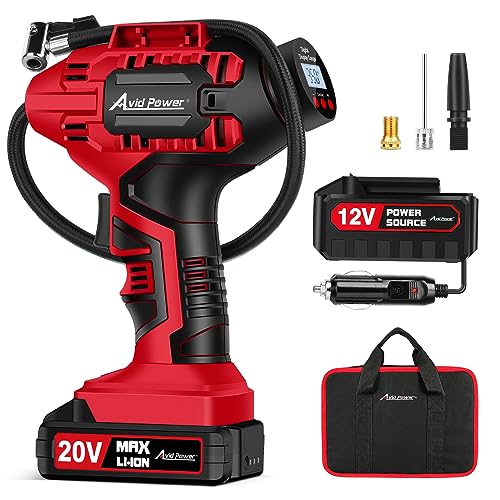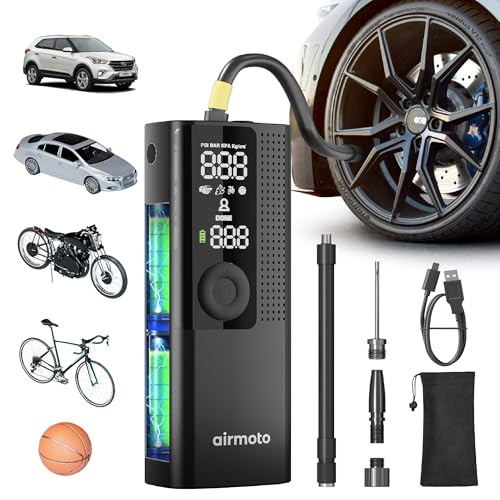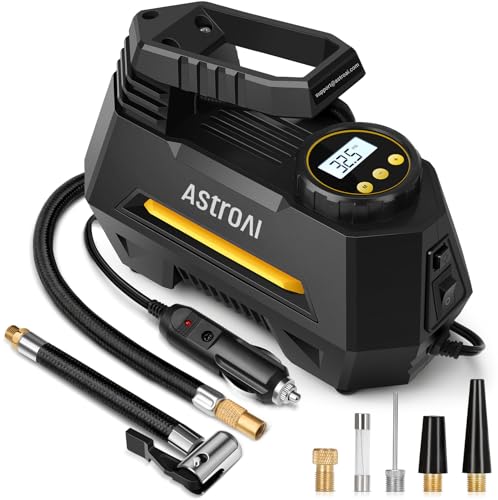Choosing The Best 12v Portable Air Compressor For 4×4 Tyres
Last weekend, I was out enjoying a scenic drive in my 4×4 when I hit a nasty patch of road. The result? A flat tire miles from anywhere. Luckily, I had my trusty 12v portable air compressor, which quickly inflated my tire and got me back on the road. This experience highlighted the importance of having a reliable 12v portable air compressor 4×4 tyre pump, and in this post, we’ll explore what to look for when choosing one, along with tips for maintenance and use.
Understanding 12V Portable Air Compressor Technology
This section explains the technology behind 12v portable air compressors for 4×4 vehicles, covering different compressor types, power sources, and key performance indicators like CFM and PSI. It will also address the importance of choosing a compressor that is compatible with your vehicle’s electrical system and tire size.
Compressor Types and Mechanisms
- Piston Compressors: These are the most common type, offering good power and durability. They operate by using a piston to draw in and compress air. The piston’s movement is driven by an electric motor powered by your vehicle’s 12V battery. The efficiency and lifespan of these compressors largely depend on the quality of the materials used in their construction and the manufacturing precision.
- Diaphragm Compressors: These use a flexible diaphragm to compress air, generally offering quieter operation and longer lifespan but potentially less power. The diaphragm, instead of a piston, moves to compress the air. These are a good option for less demanding situations where noise reduction is a priority.
Power Sources and Battery Considerations
Most 12V portable air compressors are powered directly by your vehicle’s battery. It’s crucial to check the compressor’s amperage draw to ensure it doesn’t overload your vehicle’s electrical system, especially important in older vehicles or those with smaller batteries.
- Amperage Draw: Always check the amperage draw (measured in amps) specified by the manufacturer. A higher amperage draw means the compressor requires more power from your battery. High amperage draw can lead to battery drain or damage to your electrical system if the compressor is run for extended periods.
- Battery Protection: Some compressors have built-in overload protection to prevent damage to the compressor and your vehicle’s battery. This feature automatically shuts off the compressor if the current draw exceeds a safe limit. It’s an important safety feature to look for when buying a 12V compressor.
CFM and PSI: Understanding Airflow and Pressure
Choosing the right compressor depends on understanding CFM (Cubic Feet per Minute) and PSI (Pounds per Square Inch). CFM measures the volume of air the compressor moves, while PSI measures the pressure. For 4×4 tires, you need sufficient CFM to inflate them quickly and enough PSI to reach the recommended tire pressure.
- CFM (Cubic Feet per Minute): This indicates the speed of inflation. A higher CFM rating means faster inflation times. This is especially critical in emergency situations where you need to inflate a tire quickly.
- PSI (Pounds per Square Inch): This indicates the pressure the compressor can deliver. Your 4×4 tires will have a recommended PSI range; ensure the compressor can reach and maintain that pressure.
Choosing the Right 12V Portable Air Compressor for Your 4×4
This section provides a detailed guide on selecting the appropriate 12v portable air compressor for your specific 4×4, focusing on factors such as tire size, usage frequency, and additional features.
Tire Size and Inflation Requirements
The size of your 4×4 tires directly impacts the compressor you need. Larger tires require more air volume and pressure to inflate, meaning you’ll need a compressor with a higher CFM and PSI rating. Always check your tire sidewall for the correct inflation pressure.
- Tire Volume: Larger tires have a greater internal volume, needing more air to inflate. A compressor with a higher CFM rating will be crucial for quickly inflating larger tires. Consider the volume of air needed for each tire to make an informed choice.
- Recommended PSI: Tire pressure recommendations are usually found on the tire sidewall or in your vehicle’s owner’s manual. Your compressor must achieve the required PSI.
Frequency of Use and Durability
If you frequently off-road or regularly need to inflate tires, invest in a robust, high-duty compressor. For occasional use, a less powerful, more budget-friendly option may suffice. Consider factors such as the build quality of the unit and the materials used in its construction.
- Duty Cycle: The duty cycle refers to the percentage of time the compressor can operate continuously without overheating. Higher duty cycle compressors are better for frequent or extended use. Look for duty cycle information in the specifications.
- Materials: Choose compressors made from durable materials such as metal for longer lifespan. Plastic compressors, while often cheaper, may be less resilient to the rigors of off-road use.
Additional Features to Consider
Many 12V portable air compressors offer additional features such as built-in pressure gauges, multiple nozzle attachments, and LED lights. Consider these additions based on your needs and budget. These add-ons can significantly enhance usability and convenience.
- Pressure Gauge: An accurate pressure gauge is essential for ensuring proper tire inflation. Look for a gauge with clear markings and easy-to-read numbers.
- Multiple Nozzles: Different nozzles allow you to inflate various items beyond tires, such as sports balls or inflatable toys. Consider this if you have diverse inflation needs.
Using and Maintaining Your 12V Portable Air Compressor
This section will offer practical guidance on the safe and efficient use of your 12V portable air compressor, including connection procedures, tire inflation techniques, and essential maintenance steps.
Connecting the Compressor and Inflating Tires
- Securely connect the compressor’s power cord to your vehicle’s 12V outlet (cigarette lighter or power port). Ensure a secure connection to avoid voltage drop or damage to the compressor.
- Attach the appropriate nozzle to the compressor’s air hose. Ensure it’s tightly secured to avoid leaks and maintain efficient pressure.
- Firmly attach the nozzle to your tire’s valve stem. Make sure there’s a good seal to prevent air leakage.
- Turn on the compressor and monitor the pressure gauge. Inflate your tires to the recommended PSI as shown on the tire sidewall.
- Once the tires are inflated to the correct pressure, turn off the compressor and carefully disconnect the nozzle and power cord.
Essential Maintenance for Extended Lifespan
Regular maintenance of your 12V portable air compressor is key to its longevity. This includes cleaning, lubrication, and proper storage. Neglecting these steps can reduce the compressor’s lifespan and compromise its performance.
- Cleaning: After each use, clean the compressor to remove dirt, dust, and debris. This helps to prevent damage to internal components.
- Lubrication: Depending on the compressor type, regular lubrication may be necessary. Refer to the manufacturer’s instructions for specific lubrication recommendations.
- Storage: Store the compressor in a clean, dry place, away from extreme temperatures and moisture. This prevents rust and corrosion.
Troubleshooting Common Issues
This section addresses common issues encountered with 12V portable air compressors and provides solutions. Problems range from the compressor not turning on to inconsistent air pressure. Addressing these promptly can save time and prevent costly repairs.
- Compressor Not Turning On: Check the power cord connection, fuse, and battery voltage. A dead or low battery is a frequent culprit.
- Inconsistent Air Pressure: Check for leaks in the hose and connections. A faulty pressure gauge might also be a reason for inconsistent readings.
- Overheating: Allow the compressor to cool down between uses, especially during extended operation. Overheating can damage internal components.
Debunking Myths about 12V Portable Air Compressors
This section clarifies common misconceptions related to 12v portable air compressors. Many users harbor misunderstandings about their capabilities and limitations. Understanding these clarifications allows for better purchasing decisions and usage.
Myth 1: All 12V Compressors are Created Equal
This is false. Compressors vary significantly in quality, power, and features. Cheaper models may lack the durability and performance of higher-end options.
Myth 2: A Higher CFM Always Means Better Performance
While a higher CFM is generally beneficial, it’s not the only factor to consider. PSI is equally important. A high CFM with low PSI might be insufficient for larger tires.
Myth 3: 12V Compressors are Only for Emergency Use
Many people believe these compressors are solely for emergencies, but they’re also useful for routine tire pressure checks and adjustments. Maintaining proper tire pressure improves fuel efficiency and tire longevity.
Comparing Different 12V Portable Air Compressors
Insert a comparison chart here comparing at least three different models of 12V portable air compressors, highlighting their key features, specifications (CFM, PSI, power draw), and price points. This table should aid consumers in making an informed purchasing decision.
| Feature | Compressor A | Compressor B | Compressor C |
|---|---|---|---|
| CFM | 35 | 45 | 60 |
| PSI | 150 | 120 | 180 |
| Power Draw (Amps) | 10 | 15 | 20 |
| Price | $75 | $120 | $180 |
FAQ
What is the average lifespan of a 12V portable air compressor?
With proper maintenance, a good quality 12V portable air compressor can last for several years. However, this depends heavily on the frequency of use and the quality of the compressor itself. Regular cleaning and lubrication are crucial.
How do I know if my vehicle’s battery can handle the compressor?
Check the amperage draw of the compressor and compare it to your vehicle’s battery specifications. If the compressor’s amperage draw is too high for your battery, it could lead to battery drain or damage. Consult your vehicle’s manual for details.
Can I use a 12V air compressor to inflate other things besides car tires?
Yes, many compressors come with various nozzle attachments allowing you to inflate sports balls, inflatable toys, and other similar items. Always ensure you use the correct nozzle and avoid exceeding the recommended pressure.
What should I do if my 12V compressor stops working?
First, check the power connection, fuses, and battery voltage. If the problem persists, consult the user manual for troubleshooting or contact customer support. Attempting repairs yourself may void the warranty.
How often should I maintain my 12V portable air compressor?
Cleaning should be done after every use. More involved maintenance, like lubrication, depends on the compressor’s type and manufacturer’s instructions. Regularly inspect for any damage or leaks.
Is it safe to leave the compressor running for a long time?
No, continuous running for extended periods can cause overheating and damage the compressor. Most compressors are not designed for continuous use and may have a duty cycle that limits continuous operation. Always allow sufficient cooling time between uses.
What are the safety precautions I need to take when using a 12V portable air compressor?
Always ensure the power cord is securely connected. Avoid touching moving parts while the compressor is running. Never exceed the recommended tire pressure, and always work in a well-ventilated area.
Final Thoughts
Investing in a reliable 12V portable air compressor 4×4 tyre pump can be a lifesaver, particularly for off-road enthusiasts. By understanding the key specifications like CFM and PSI, and choosing a model that meets your specific needs, you’ll be well-prepared for any tire inflation challenges you might encounter. Remember that regular maintenance is crucial to extend the life of your compressor and ensure its continued efficient operation. Choose wisely and stay prepared for any flat tire emergencies!





